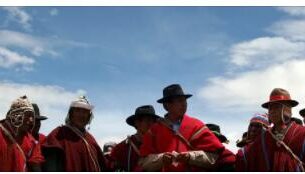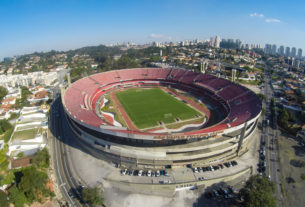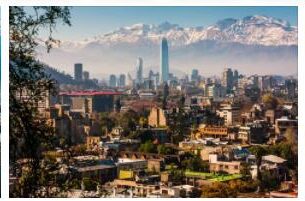TERRITORY: MORPHOLOGY
Two fifths approx. of the Bolivian territory are included in the Andean region; the remainder extends over the lowlands and the modest elevations at the limit between the Amazon and the Platense basins. In the Andean section, generically called Altiplano in Bolivia, the Andes reach their maximum width; the system splits into the mighty chains of the Cordillera Oriental and the Cordillera Occidental which enclose an imposing expanse of arid plateaus, a continuation of the Peruvian ones, located at an average altitude of 4000 m. The Cordillera Occidental, formed by a mighty alignment of volcanoes – almost all of them inactive – dominated by Nevado Sajama(6542 m), it remains on the edge of the Bolivian territory, while the Oriental one constitutes the most important structural element of the country; it hosts some of the highest Andean peaks, such as Nevado Illimani (6457 m) and Nevado Illampu (6421 m), which with other majestic peaks form the so-called Royal Cordillera (Cordillera Real) dominating Lake Titicaca. From the structural point of view, the plateaus are formed by a large clod with peneplanate surfaces raised rigidly by the Andean orogeny ; morphologically they have bare and low ridges that border large depressions partly occupied by lake basins, of which that of Lake Titicaca is the largest and most marked. Geologically there are formations in the depression areas neozoic, while the underlying Paleozoic layers emerge on the reliefs. The Cordillera Oriental is more complex: large intrusive crystalline pillars appear among the paleozoic metamorphic rocks, while in its layers there are paleozoic and Mesozoic sedimentary formations. With a series of large folds and fold-faults the chain drops steeply to the E; the side is furrowed by long and deep valleys that flow into the eastern lowlands (in Bolivia called the Orient), where the formations of the ancient Precambrian base emerge in the dividing penepiano between the Amazon and the Platens basins, both covered by Cenozoic layers and more recent river floods.
TERRITORY: HYDROGRAPHY
Hydrographically approx. three-fifths of Bolivia is a tribute to the Amazon basin or to the Platense basin; the rest forms an endorheic surface that collects its waters either in the vast (8300 km²) Lake Titicaca (connected by the Río Desaguadero with the other main Bolivian lake, the Poopó) or in the great salares, such as that of Uyuni, brackish marshes from extremely variable limits that occupy the depressions of the plateau where, given the very scarce precipitations, there is the endorheism typical of arid regions. The development of exoreic hydrographyon the rainy side of the Cordillera Oriental it has gradually captured the endorheic basin of the plateau; the rivers penetrate deeply towards the west, opening the passage between one section and the other of the cordillera with marked valley engravings (valles). The main ones are the Beni and the Mamoré, which pay tribute to the Amazon River through the Madeira and the Pilcomayo, which descends to the Paranávia Paraguay. These rivers receive numerous tributaries from the eastern side of the cordillera; the greatest supply of water begins in the middle part of the same slope, in relation to the most abundant rainfall and where the rivers, after passing the waterfalls that often interrupt their upper course, begin to be navigable.
TERRITORY: CLIMATE
The climate of Bolivia changes sharply from the Altiplano to the East.In the first we find those conditions of aridity typical of the Andean highlands and due to the barrier exerted by the cordillera against the air masses of Atlantic and Pacific origin; the whole E side of the Cordillera Oriental, as well as the lowlands below, are instead subject to Atlantic cyclonic influences. The climate of the lowlands can be defined as subequatorial with a transition to clearly tropical conditions towards the S, that is towards the Chaco; rainfall fluctuates between 1500 and 1000 mm per year, with attenuations during the austral winter the more marked the further one proceeds towards S; temperatures vary on average from 28 ºC to 24 ºC, respectively in January and July. We are here in the tierras calientes, which end on the side of the cordillera towards 1500 m, where the more mitigated and even rainiest strip begins: it is the templean environment of the yungas, rich in vegetation and well cultivated, which reach up to 2500 m. At this altitude the Altiplano practically begins with its continental climate and the first hints of aridity; starting from 3000 m approx. the tierras frías begin, with thermal averages in January never exceeding 10-12 ºC and averages in July which drop to 7-8 ºC.
CULTURE: GENERAL INFORMATION
As a country located in South America according to physicscat, Bolivia has long been affected, also from a cultural point of view, by the strong isolation due to the geomorphology of its territory and historical-political events. In the cities, the recovery of a certain cultural vitality together with the willingness to embrace international influences and suggestions took shape during the second half of the twentieth century; conversely, the more traditional ways of life of the Indians, of great charm but also synonymous with precariousness and poverty, remain very strong especially in the lowlands, less touched by modernity than in western urban centers. Religion and folklore are the areas in which the manifestation of archaic customs is most alive, although they are not rare hybrid forms of spirituality, the result of European influences. Numerous are the festivals, religious and profane, in which the dances in costume, or in masks, and the rites of the Inca era still find very strong popular participation. The exponents of the arts and literature have often contributed to giving voice to issues such as the preservation of the roots, the account of the life of the villages of the Indians, the search for a national identity, the description of the tormented events of the past, the denunciation of disparities between a wealthy minority and a large part of the population on the verge of subsistence. In the country there are several institutions that work for the dissemination of culture, from universities to museums to those of foreign origin such as the Bolivian American Center, the Alliance Française, the British Council, the Casa de España. Further evidence of the remarkable national heritage are the five sites protected by UNESCO: the city of Potosí (1987),El fuerte di Samaipata (1998) and the Spiritual and Political Center of Tiwanaku Culture (2000).



